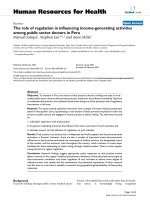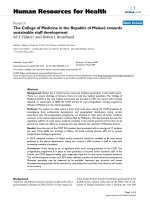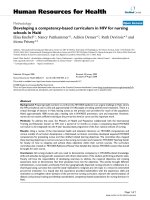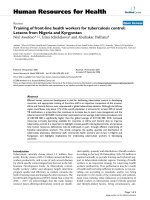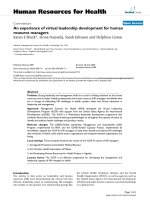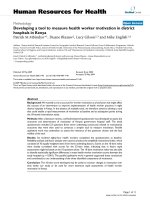báo cáo sinh học:" Developing a competency-based curriculum in HIV for nursing schools in Haiti" pdf
Bạn đang xem bản rút gọn của tài liệu. Xem và tải ngay bản đầy đủ của tài liệu tại đây (241 KB, 7 trang )
BioMed Central
Page 1 of 7
(page number not for citation purposes)
Human Resources for Health
Open Access
Methodology
Developing a competency-based curriculum in HIV for nursing
schools in Haiti
Elisa Knebel
†1
, Nancy Puttkammer
†1
, Adrien Demes*
2
, Ruth Devirois*
3
and
Mona Prismy*
2
Address:
1
International Training and Education Center on HIV (I-TECH), University of Washington, 901 Boren Avenue, Suite 1100 Seattle, WA
98104-3508, USA,
2
International Training and Education Center on HIV (I-TECH)/Haiti, Delmas 95, Route de Jacquet #14, Petion Ville, Haiti and
3
Institut Haïtien de Santé Communautaire, Angle rues Rigaud et Lambert, Pétionville, B.P. 13408, Haiti
Email: Elisa Knebel - ; Nancy Puttkammer - ; Adrien Demes* - adriendemes@itech-
haiti.org; Ruth Devirois* - ; Mona Prismy* -
* Corresponding authors †Equal contributors
Abstract
Background: Preparing health workers to confront the HIV/AIDS epidemic is an urgent challenge in Haiti, where
the HIV prevalence rate is 2.2% and approximately 10 100 people are taking antiretroviral treatment. There is a
critical shortage of doctors in Haiti, leaving nurses as the primary care providers for much of the population.
Haiti's approximately 1000 nurses play a leading role in HIV/AIDS prevention, care and treatment. However,
nurses do not receive sufficient training at the pre-service level to carry out this important work.
Methods: To address this issue, the Ministry of Health and Population collaborated with the International
Training and Education Center on HIV over a period of 12 months to create a competency-based HIV/AIDS
curriculum to be integrated into the 4-year baccalaureate programme of the four national schools of nursing.
Results: Using a review of the international health and education literature on HIV/AIDS competencies and
various models of curriculum development, a Haiti-based curriculum committee developed expected HIV/AIDS
competencies for graduating nurses and then drafted related learning objectives. The committee then mapped
these learning objectives to current courses in the nursing curriculum and created an 'HIV/AIDS Teaching Guide'
for faculty on how to integrate and achieve these objectives within their current courses. The curriculum
committee also created an 'HIV/AIDS Reference Manual' that detailed the relevant HIV/AIDS content that should
be taught for each course.
Conclusion: All nursing students will now need to demonstrate competency in HIV/AIDS-related knowledge,
skills and attitudes during periodic assessment with direct observation of the student performing authentic tasks.
Faculty will have the responsibility of developing exercises to address the required objectives and creating
assessment tools to demonstrate that their graduates have met the objectives. This activity brought different
administrators, nurse leaders and faculty from four geographically dispersed nursing schools to collaborate on a
shared goal using a process that could be easily replicated to integrate any new topic in a resource-constrained
pre-service institution. It is hoped that this experience provided stakeholders with the experience, skills and
motivation to strengthen other domains of the pre-service nursing curriculum, improve the synchronization of
didactic and practical training and develop standardized, competency-based examinations for nursing licensure in
Haiti.
Published: 29 August 2008
Human Resources for Health 2008, 6:17 doi:10.1186/1478-4491-6-17
Received: 29 January 2008
Accepted: 29 August 2008
This article is available from: />© 2008 Knebel et al; licensee BioMed Central Ltd.
This is an Open Access article distributed under the terms of the Creative Commons Attribution License ( />),
which permits unrestricted use, distribution, and reproduction in any medium, provided the original work is properly cited.
Human Resources for Health 2008, 6:17 />Page 2 of 7
(page number not for citation purposes)
Background
In light of severe physician shortages in the developing
world, the World Health Organization's strategic frame-
work for the emergency scale up of antiretroviral therapy
(ART) involves training a range of health-care staff to sup-
port the delivery and monitoring of HIV/AIDS treatment.
'Task shifting' is the name given to a process of delegation
whereby tasks are moved, where appropriate, to less spe-
cialized health workers [1].
Task shifting has lead nurses to be heavily involved in per-
forming HIV testing and counselling, assessing patients
for ART eligibility, assessing toxicity and treatment failure,
and providing patient education, psychosocial support
and adherence support [2]. Nurses may also play a lead
role in record keeping and reporting. As the volume of
patients under HIV/AIDS care and treatment services
grows and services are decentralized, nurses may experi-
ence a shift of responsibilities, with even larger roles in
initial evaluation and staging of patients, ART initiation,
and patient monitoring [3].
As nurses are becoming increasingly central points of con-
tact for clinical care of people living with HIV and AIDS
(PLWHA), they must first be ensured adequate prepara-
tory education. Scattered reports have shown, however,
that most nurses in developing countries are not well pre-
pared during their pre-service education in the knowl-
edge, skills and attitudes needed to provide quality HIV/
AIDS-related care [4,5].
Preparing nurses to confront the HIV/AIDS epidemic is a
need in Haiti where the HIV prevalence rate is 2.2% [6],
approximately 10 100 patients are currently receiving
antiretroviral treatment [7], and there is a critical shortage
of doctors, leaving nurses as the primary care providers for
much of the population.
Haiti has four national nursing schools, graduating
approximately 120 registered nurses per year. These
schools face under-resourced infrastructure (few text-
books and teaching materials and little classroom space),
variable quality of teaching with few classroom instructors
prepared to educate, and few clinical instructors and sites
available for clinical skills practice. Graduates often must
do much of their learning on-the-job during their rota-
tions, under limited supervision. Specific to HIV/AIDS
education, a recent assessment revealed that related con-
tent is very loosely woven throughout the courses, and
that inclusion of HIV is arbitrarily dependent on the inter-
est of the faculty member assigned to the course, with key
areas, such as HIV/AIDS counseling, prevention of
mother-to-child transmission, and ART adherence, being
largely overlooked [8].
Since 2004, the International Training and Education
Center on HIV (I-TECH) has worked in Haiti to build
capacity to respond to the AIDS epidemic. I-TECH is a col-
laboration between the University of Washington and
University of California San Francisco and was established
by the Health Resources and Services Administration
(HRSA) in collaboration with the Centers for Disease
Control and Prevention (CDC).
In June 2006, the Haitian Ministry of Health and Popula-
tion (MSPP), specifically the directorate that is in charge
of health science education, the Direction de Formation et
de Perfectionnement en Sciences de la Santé (DFPSS), and I-
TECH started a process of integrating current HIV/AIDS
knowledge, skills and attitudes into the current curricu-
lum using a competency-based approach. This article
details the steps undertaken to develop, integrate and
implement the new curriculum.
Methods
In June 2006, DFPSS and I-TECH convened deans of the
four public nursing schools, officials from the Haiti min-
istries of health and education, and selected education
and HIV/AIDS experts to reflect on the status of HIV/
AIDS-related education at the nursing schools and how to
quickly address new content into an already overloaded
curriculum in a resource-strained environment.
The stakeholders chose to form two committees – a coor-
dinating committee made up of school heads and minis-
try officials that would ensure broad-based support and
integration of the new topic into the existing curriculum
and an eight-member curriculum committee made up of
Haitian nurse educators, nurse trainers and one nurse
HIV/AIDS expert to draft the new curriculum.
Upon review of other international projects and the edu-
cation literature on various models of curriculum devel-
opment and integration, stakeholders opted to use a
competency-based approach for the integration process.
A competency is defined as the blend of skills, abilities,
and knowledge needed to perform a specific task [9]. In
both developed and developing countries, the traditional
approach to nursing pre-service education has been for
teachers to determine what content needs to be learned,
teaching it, and then testing to see if the content was
learned. This approach, though long established, does not
guarantee that teachers use content reflecting the needs of
the workplace and often relies on passive memorization
from lectures as the dominant learning method for stu-
dents. The literature is full of calls for curriculum reform
in nursing education, advocating curricula that are
responsive to changes in the health care delivery system,
Human Resources for Health 2008, 6:17 />Page 3 of 7
(page number not for citation purposes)
are research-based, are collaborative, and apply pedagogi-
cal innovation [10].
Recent reforms support the application of competency-
based education – defining, teaching, and assessing com-
petencies and then assessing student performance in rela-
tion to these, thus focusing on the outcome of the
education, rather than on the process of the education
(applying knowledge and skills rather than merely gain-
ing knowledge) [11]. Experience shows that using compe-
tencies to define what is taught in the pre-service arena
can achieve the following: provide clarity of learning
direction for both faculty and students, set the framework
for assessment, enable the curriculum to reflect the "real
world" skills required to meet the health needs of the pop-
ulation and clarify the role of nurses vis-à-vis the other
health professions [11-15].
A competency-based education model starts by asking the
question: What will the nurse do on the job? Once this is
known, specifications of learning objectives for instruc-
tion are derived. If integrating a new theme into an exist-
ing curriculum, these learning objectives can then be
mapped to existing courses. Then, appropriate teaching
and assessment methods are derived that will ensure mas-
tery of the objectives, and faculty are trained in and ori-
ented to the new curriculum. Finally, evaluation is
conducted to ensure that students achieve mastery of the
competencies. A schematic representation of this model
appears in Figure 1.
Results
When the curriculum committee began to design the new
curriculum, the initial hurdle was to articulate and reach
consensus on the HIV/AIDS competencies relevant for
nurses. In-depth discussions among the participating
experts at the beginning of the project, who had a good
overview of the ongoing HIV/AIDS activities in Haiti,
helped to identify a draft list of general competencies.
Then, the curriculum committee reviewed HIV competen-
cies relevant for developing country settings, which were
drafted by the World Health Organization [16] and the
National HIV Nursing Association [17] in the United
Kingdom. Over a series of seven meetings, the committee,
through facilitated discussions, adapted these competen-
cies to the Haitian environment and formed a final list of
five main HIV/AIDS competencies and 35 associated sub-
competencies as shown in Table 1.
The committee then defined the associated learning
objectives for each sub-competency. Over 350 learning
objectives were defined, with each sub-competency hav-
ing multiple knowledge, skill and attitudinal learning
objectives. The committee then mapped each of these
objectives to existing courses in the overall nursing curric-
ulum. Hours were not taken from existing courses to spe-
cifically make room for the new objectives, nor were
additional hours added to the curriculum, but rather, the
new HIV/AIDS-related learning objectives were integrated
into the current courses. For example, in the Counseling
and Communication course, when discussing how to use
job aids and demonstrate good interpersonal skills, the
faculty member is prompted to use an example of ART
adherence counseling.
The learning objectives build upon each other at different
stages in the curriculum. For example, a student nurse in
year 1 will describe the relationship between HIV and
nutrition, but by the years 3 and 4, she or he is able to
define dietary needs of specific sub-groups of PLWHA and
how to educate patients on specific meal preparation.
To support faculty with up-to-date HIV/AIDS content, the
committee drafted an 'HIV/AIDS Reference Manual' that
features evidence-based national and international core
content, protocols, and guidelines for faculty to access.
Competency-based education modelFigure 1
Competency-based education model.
Human Resources for Health 2008, 6:17 />Page 4 of 7
(page number not for citation purposes)
The committee also drafted a 'HIV/AIDS Teaching Guide'
organized by curriculum year and course, which was
approved for dissemination to the nursing schools by the
MSPP in November, 2007. For each course, the associated
competency and sub-competencies, learning objectives,
recommended chapters of the 'Reference Manual' or other
materials, learning methods and evaluation methods are
listed. An excerpt of a plan for a specific course is shown
in Table 2.
As noted, a key tenet of competency-based education is
moving away from rote memorization or knowledge
acquisition to the application of knowledge and skills. As
such, the 'Teaching Guide' places great emphasis on a mix
of interactive teaching methods to stimulate active stu-
dent participation, such as case-based learning, role plays,
and group discussions. The 'Teaching Guide' ensures inte-
gration between theory and practice, as many of the
Table 1: HIV Competencies and sub-competencies
Competencies Sub competencies
A. Prevent HIV infection among individuals and the community A.1 Conduct community and individual education on HIV/AIDS
A.2 Perform HIV pre-test counseling
A.3 Conduct HIV testing
A.4 Perform HIV post-test counseling
A.5 Prevent and treat accidental blood exposure
A.6 Prevent Mother-To-Child-Transmission of HIV
A.7 Prevent and treat sexually transmitted diseases
A.8 Ensure post-exposure prophylaxis in cases of sexual violence
B. Promote the health of people living with HIV B.1 Provide counseling on well-being and nutrition
B.2 Prevent opportunistic infections
C. Evaluate the health status of people living with HIV C.1 Identify the clinical signs of HIV infection
C.2 Conduct biologic tests
C.3 Classify the patient according to stages of infection as defined by
WHO and the CDC
D. Ensure the care of adults and children infected with HIV/AIDS D.1 Therapeutic interventions
D.1.1 Identify the patients eligible for ART
D.1.2 Counsel for adherence to ART
D.1.3 Treat opportunistic infections
D.1.4 Manage the nutrition of PLWHA
D.1.5 Administer ART
D.1.6 Ensure the follow-up of a patents taking ART
D.1.7 Manage a pregnant women infected by HIV
D.1.8 Manage a child infected by HIV
D.1.9 Provide palliative care
D.2 Psychosocial and community interventions
D. 2.1 Provide spiritual support
D. 2.2 Provide social and economic support
D. 2.3 Provide psychological support
D.2.4 Support clients in managing grief
D. 2.5 Link patients to legal support
D. 2.6 Provide support to orphans and other vulnerable children
D. 2.7 Ensure the community management of people living with HIV
D.2.8 Prevent and treat burn-out among n
E. Ensure the management of various aspects of the HIV/AIDS control
program
E.1. Work as a member of a multidisciplinary team
E.2. Manage the drugs and other inputs necessary for the care of people
living with HIV
E.3. Manage the data entry of HIV patients
E.4. Utilize the resources provided in the national AIDS control program
E.5. Evaluate the activities of the national AIDS control program
Human Resources for Health 2008, 6:17 />Page 5 of 7
(page number not for citation purposes)
course plans specify practice-based experience with nurse
monitors in a clinic setting.
Typically, the sole form of assessment in Haiti nursing
schools is a final written examination, of essay, short
answer or multiple-choice type. However, such examina-
tions tend to reward rote recall of facts and don't assess a
student's ability to apply knowledge in practice. The
'Teaching Guide' emphasizes structured observation as an
alternative assessment method and emphasizes periodic
assessment at regular intervals throughout each course.
The final exam for nurses to obtain their license to practice
will also be modified to reflect the new competencies.
It has been noted that faculty development is probably the
single most necessary precursor to the successful imple-
mentation and maintenance of curricular reform [18,19].
Unless faculty members embrace the new content, expand
their own knowledge base, and successfully integrate the
new content into the curricula, curriculum reform simply
cannot be made. To that end, a series of faculty develop-
ment workshops have recently begun on the new content
of the HIV/AIDS curriculum and on how to lead interac-
tive teaching methodologies that not only enhance stu-
dent knowledge but skills and attitudes. The curriculum
committee will be working with faculty from each school
in the coming months to design checklists that enable
observation and judgments to be made about the stu-
dents' mastery of the learning objectives. Curriculum
committee members are also performing periodic site vis-
its to the nursing schools to observe teaching activities,
mentor faculty, and monitor and evaluate the implemen-
tation of the curriculum package.
Over the next four years, as students progress from Year 1
through Year 4 of the degree program, the HIV/AIDS cur-
riculum will be evaluated formally in all four schools. In
addition, data on faculty use of and satisfaction with the
curriculum will be collected through semi-structured
qualitative interviews and observation, the results of
which will be used to identify any weaknesses and needed
changes to the Teaching Guide or Reference Manual, as
related to the level of difficulty, time allocation, content
updates, or other areas. A revision schedule has not been
set for the teaching material, as another goal of faculty
development will be to build their skills in maintaining
their currency in their field and to reflect this in lesson
planning.
Discussion
The effect of this change has broad implications for the
Haiti nursing education community. All nursing students
will now need to demonstrate mastery of HIV/AIDS-
related competencies during periodic assessment with
direct observation of the learner performing authentic
tasks. Using what they learned in the faculty development
workshops and the instructions and model exercises in
the 'HIV/AIDS Teaching Guide', faculty will have the
added responsibility of developing exercises to address
the required competencies and creating assessment tools
to demonstrate that their graduates have met the compe-
tencies. The major challenges in the next step will be cre-
ating assessment tools that are reliable, valid, and
practical in this developing country setting.
There were several lessons learned from the process of
developing the HIV competencies and integrating them
into an already established broader nursing curriculum.
Table 2: Sample course plan: infectious diseases, year 2
Competency Sub-competency Learning objectives Content source Learning methods Assessment method
A. Prevent HIV
infection among
individuals and the
community
A.5 Prevent and treat
accidental blood
exposure (ABE)
Describe the role of
nurse in the
prevention and
treatment of ABE (K)
Chapter 3 in HIV
Reference Manual
Large group
discussion and lecture
Written exam
Indicate the risks and
degree of risk of ABE
(K)
Chapter 3 in HIV
Reference Manual
Case study Case analysis
Respond with
legitimating statements
when a victim of ABE
expresses shock (A)
Chapter 3 in HIV
Reference Manual
Role play Observation checklist
Demonstrate capacity
to apply universal
precautions and waste
management (S)
Chapter 3 in HIV
Reference Manual
Clinic rotation Observation checklist
(K) = Knowledge, (S) Skill, (A) Attitude
Human Resources for Health 2008, 6:17 />Page 6 of 7
(page number not for citation purposes)
The first lesson was the importance in identifying the right
stakeholders for both the coordinating committee and the
curriculum working groups. For both groups, bringing a
multidisciplinary group of officials, faculty, administra-
tors and HIV experts enriched the process, garnered buy-
in, and improved the outcome by virtue of the collabora-
tive process. The curriculum working group was made up
of dedicated nurse leaders who were passionate about ele-
vating the profile of nursing education in Haiti and grad-
uating students competent to care for the large number of
people living with HIV and AIDS.
The second lesson was that this activity brought different
nursing schools together to collaborate on a shared goal
that was manageable and timely using a process that
could be repeated for other aspects of curriculum reform.
Haiti's nursing schools face numerous challenges: lack of
funds, lack of available clinical mentors, poor infrastruc-
ture, lack of curriculum developers, etc. Against this back-
drop, other aspects of the overall nursing curriculum
program need major reform but addressing only one topic
through this systematic process gave the schools a man-
ageable victory. It is hoped that this provided stakeholders
with the experience, skills and motivation to strengthen
other domains of the pre-service nursing curriculum,
improve the synchronization of didactic and practical
training, and develop standardized competency-based
examinations for nursing licensure in Haiti. Each of these
goals is part of the Ministry of Health's strategic plan for
2005–10 [20].
The third lesson was that defining competencies and
related learning objectives, though absolutely essential to
clarifying what students must learn, was conceptually dif-
ficult for the curriculum committee. Even experienced
educators may find it challenging to clearly state the
knowledge, skills, and attitudes underpinning a compe-
tency. Writing clear and measurable learning objectives,
particularly attitudinal objectives, was challenging for the
committee, and required a great deal of debate and revi-
sion.
It is necessary to develop the evidence base on the impact
of pre-service curriculum strengthening initiatives in
developing countries like the one described here [21].
There is not one HIV care delivery model in Haiti, mean-
ing that pre-service programs have to provide flexible edu-
cation which will allow nurses to integrate into settings
with varied types of HIV-related services and with varied
staffing patterns. Applied research is needed in settings
like Haiti on the optimal role of nurses in support of HIV
scale-up, the integration of HIV care and treatment with
other components of primary care services, and the rela-
tionship between pre-service nursing training, quality of
care, and patient health outcomes. On-going evaluation
and documentation of Haiti's pre-service training initia-
tive for nurses will hopefully yield insights useful for other
settings and professional disciplines.
Conclusion
In light of the critical role that nurses play in the care of
Haiti's population, investing in pre-service nursing educa-
tion institutions to improve the quality of HIV/AIDS
training is a critical part of increasing the overall quality of
HIV/AIDS care and treatment in the country. Education in
HIV/AIDS is now an integral part of the four national
nursing schools in Haiti. This was achieved using a multi-
disciplinary, participatory process that can be applied to
future curriculum reform efforts.
Competing interests
The authors declare that they have no competing interests.
Authors' contributions
EK provided technical assistance to the nursing committee
and drafted the manuscript. NP conceived of the interven-
tion, participated in its coordination, and helped to draft
the manuscript. AD supported the technical committee.
RD and MP participated in the design and implementa-
tion of the intervention. All authors read and approved
the final manuscript.
Acknowledgements
Ruth Derivois, of the Institut Haitien de Sante Communautaire (INHSAC),
and Mona Prismy, Training Manager for I-TECH Haiti, led the Technical
Committee. The curriculum committee undertook the needs assessment
and curriculum development work described in this article; it's members
include: Marie Roselène M. Mécéjour, DFPSS/MSPP, Marie Danielle Neff
Lemaire, DFPSS/MSPP, Marie Maud César Duvilaire, DSI/MSPP, Edite Valcin
Legagneur, Family Health International, Gardénia Monrose, Independent
Consultant, and Claudia Thomas Riché, Centres GHESKIO/I-TECH Con-
sultant. Dr. Nancy Rachel Labbe Coq, Dr. J.E. Adrien Demes, and Ms. Paula
Brunache of I-TECH Haiti and Dr. Paul Carrenard of INHSAC provided
oversight and resources in support of the technical committee.
The work described in this article was supported by the US President's
Emergency Plan for AIDS Relief (PEPFAR), through funding to the Univer-
sity of Washington from the US Health Resources and Services Administra-
tion (HRSA) Global HIV/AIDS Bureau. The funding body (PEPFAR) was not
involved in the implementation of the work described, nor in the prepara-
tion of this manuscript and decision to submit it for publication. I-TECH
takes full responsibility for the needs assessment study design, data collec-
tion and analysis, development of nursing competencies, and curriculum
design described in this article.
References
1. World Health Organization: Task shifting to tackle health
worker shortages. Geneva 2007.
2. Hirschhorn LR, Oguda L, Fullem A, Dreesch N, Wilson P: Estimat-
ing health workforce needs for antiretroviral therapy in
resource-limited settings. Hum Resour Health 2006, 4:1.
3. Gimbel-Sherr S, Micek M, Gimbel-Sherr K, Koepsell T, Hughes J, Tho-
mas K, Pfeiffer J, Gloyd S: Using nurses to identify HAART eligi-
ble patients in the Republic of Mozambique: results of a time
series analysis. Hum Resour Health 2007, 28(5):7.
Publish with Bio Med Central and every
scientist can read your work free of charge
"BioMed Central will be the most significant development for
disseminating the results of biomedical research in our lifetime."
Sir Paul Nurse, Cancer Research UK
Your research papers will be:
available free of charge to the entire biomedical community
peer reviewed and published immediately upon acceptance
cited in PubMed and archived on PubMed Central
yours — you keep the copyright
Submit your manuscript here:
/>BioMedcentral
Human Resources for Health 2008, 6:17 />Page 7 of 7
(page number not for citation purposes)
4. Bharat S, Mahendra VS: Meeting the Sexual and Reproductive
Health Needs of People Living with HIV: Challenges for
Health Care Providers. Reproductive Health Matters 2007, 15(29
Supplement):93-112.
5. World Health Organization: Nursing Role in HIV/AIDS Care and
Prevention in South-East Asia Region. Geneva 2002.
6. Ministre de la santé publique et de la population (MSPP): Pro-
gramme national de lutte contre les IST/VIH-SIDA. Reunion
de restitution du rapport UNGASS Haiti 2007. Presentation.
Port-au-Prince 2008.
7. Latest 2007 PEPFAR Treatment Results [
far.gov/press/85520.htm]
8. International Training and Education Center on HIV (I-TECH):
Needs assessment of Haiti nursing schools. Port-au-Prince 2006.
9. National Postsecondary Education Cooperative: Defining and
assessing learning: Exploring competency-based initiatives.
Washington, DC 2002.
10. Giddens J, Brady D: Rescuing Nursing Education from Content
Saturation: The Case for a Concept-Based Curriculum. Jour-
nal of Nursing Education 2007, 46(2):65-9.
11. Carraccio C, Wolfsthal SD, Englander R, Ferentz K, Martin C: Shift-
ing Paradigms: From Flexner to Competencies. Academic
Medicine 2002, 77(5):361-367.
12. World Health Organization: Nurses and Midwives for Health:
WHO European Strategy for Nursing and Midwifery Educa-
tion. Geneva 2001.
13. Center for Health Policy, Columbia University School of Nursing and
Association of Teachers of Preventive Medicine: Competency-to-
Curriculum Toolkit. New York: Columbia University School of
Nursing and Association of Teachers of Preventive Medicine. New
York; 2004.
14. Foss GF, Janken JK, Langford DR, Patton NM: Using professional
specialty competencies to guide course development. Journal
of Nursing Education 2004, 43(8):368-75.
15. Tanner C: Competency-based education: The new panacea?
Journal of Nursing Education 2004, 40(9):387-388.
16. World Health Organization: Core Competencies: results from
the International Consensus Meeting on HIV Service Deliv-
ery Training and Certification. Geneva 2005.
17. National HIV Nurses Association: NHIVNA National HIV Nurs-
ing Competencies. London, Mediscript LTd; 2007.
18. Kupperschmidt BR, Burns P: Curriculum revision isn't just
change: it's transition! J Prof Nurs 1997, 13(2):90-8.
19. Latimer D, Thornlow DK: Incorporating geriatrics into bacca-
laureate nursing curricula: laying the groundwork with fac-
ulty development. J Prof Nurs 2006, 22(2):79-83.
20. Ministère de la Santé Publique et de la Population: Plan Stratégique
National pour la Réforme du Secteur de la Santé: 2005–2010.
Port-au-Prince, Haiti 2005.
21. McCarthy EA, O'Brien ME, Rodriguez WR: Training and ART
scale-up: establishing an implementation research agenda.
PLoS Medicine 2006, 3(7):989-993.
